14 Nights Marmaris Yacht Charter Itinerary
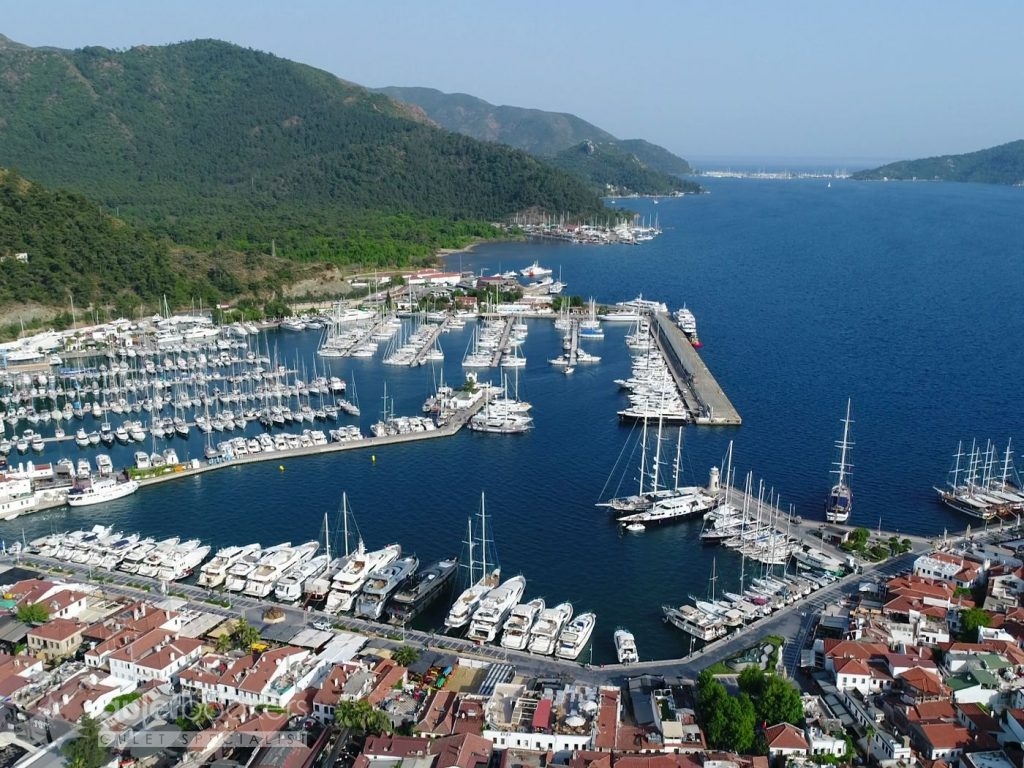
Marmaris is one of the rare towns in Turkey where you can swim right in the city centre, despite the increased construction, as enviromental and water treatment facilites have been installed. For those who seek cleaner seas and quieter spots there are many gulet trips that go to other bays. Stroll and explore the bustling Marmaris bazaar, getting the feeling of being in Asia Minor. Marmaris in recent years has spread out with new hotels and apartments but the old centre still retains its village atmosphere. Marmaris has a great choice of shops and restaurants many with an international flavour. The most important historic building in the town centre is the castle. The first castle built on this site was constructed up by the Ionians, with the present castle you see being built by the Ottomans in 1522. After the Ottoman Sultan Suleyman the Magnificent conquered the city in 1522, many buildings were built which are still visitabl today. Apart from its clean sea and shopping, Marmaris is also famous for its nightlife. Marmaris is accessible by international travellers via Dalaman International Airport (DLM) – Marmaris being 90 minutes and Bodrum Milas International Airport (BJV) – Marmaris being two and half hours.
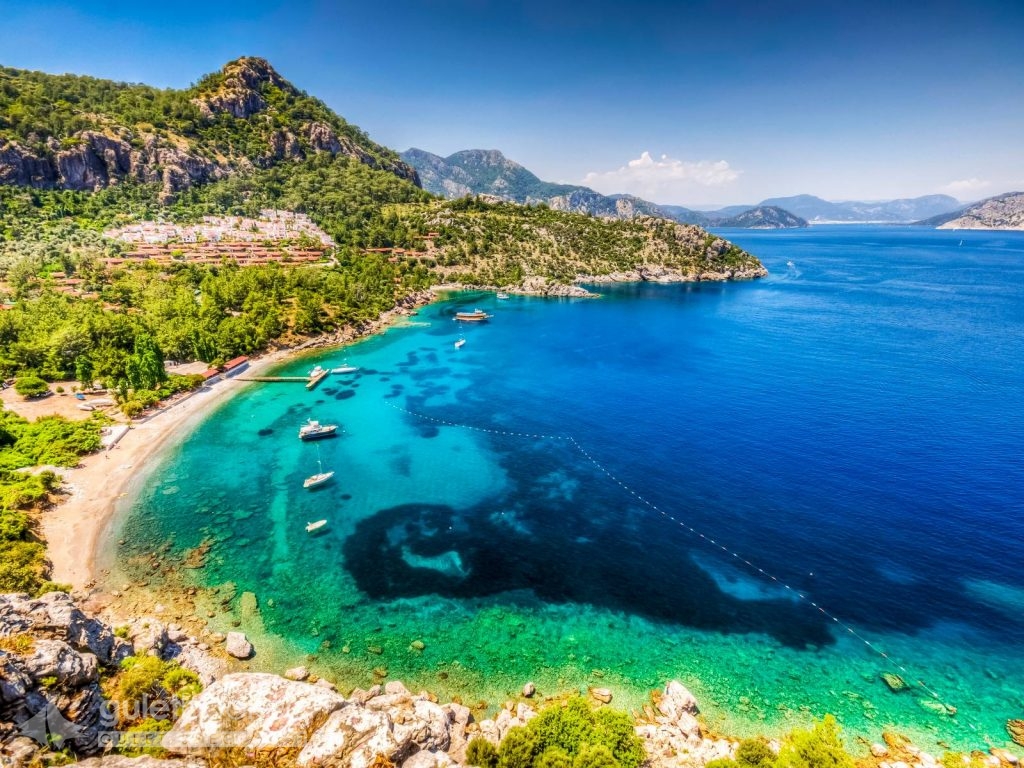
Among the coves after you leave Marmaris are beaches of Turunc and Kumlubuk. In Turunc bay, you will see a beautiful painted sea with a special tone of blue. There are all shades of blue in the water: indigo blue, glass blue, and the blue of the sky reflected on the water and others. Turunc is hemmed it by a high covered in pines trees that bring a coolness to the seaside. Although it is always sunny it is not that hot. And of course pomegranate, mulbery, plums and citrus trees abound, through being called Turunc (Citrus) you would expect more citrus trees, throug to make up for this there are geraniums, oleanders and begonias everywhere. Turunc is one of the indispensable stops on the Blue Cruise.
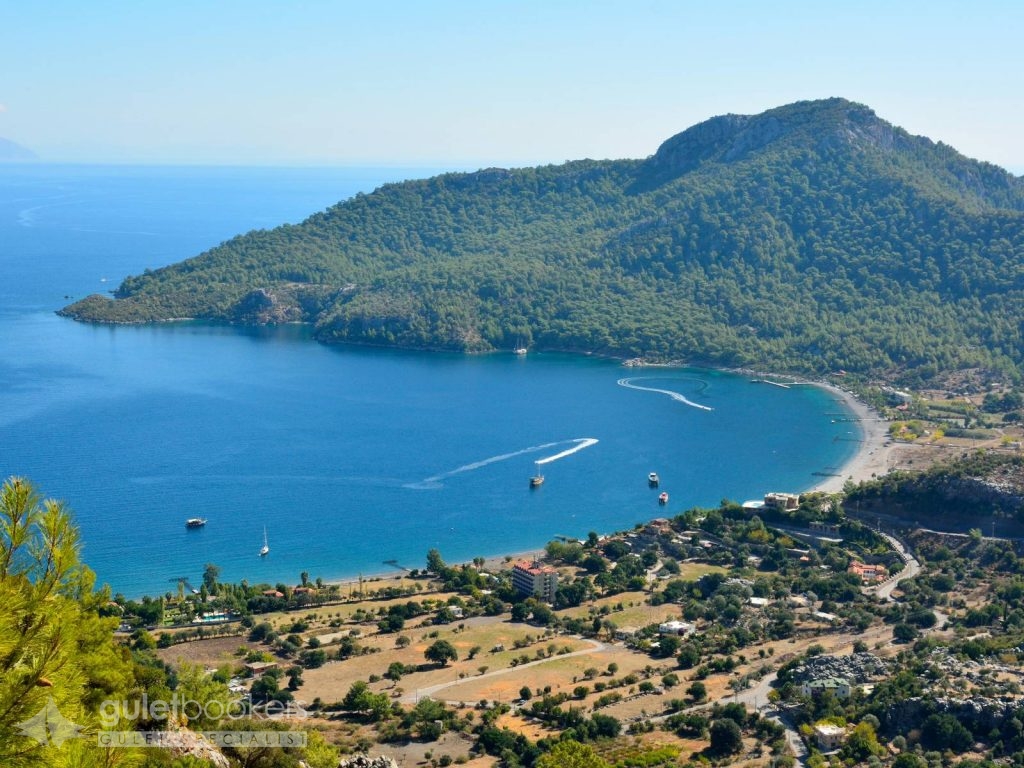
Kumlubuk is famous for its beautiful beaches that you could spare one of your evenings or mornings to walk to the ancient city of Amos, which is half an hour on foot from Kumlubuk. Amos was one of the most important ancient cities of its time, though today little remains. On the narrow and long flat space on the hill top above the gravel beach between Hisar Burnu (Fortress Point) and Kumubuk, you will see the theatre and the cith walls. The necropolis of the ancient city is leaning on the hillside above the small cove to the North. However, you will be more impressed by the stunning view below you rather than the ruins.
Kadirga
The Kadirga Cove, which is right before Kadirga point and on which there is a white lighthouse and the house of the keper, is another stopping plaxe. Boats coming from Marmaris take a swimming break in here.
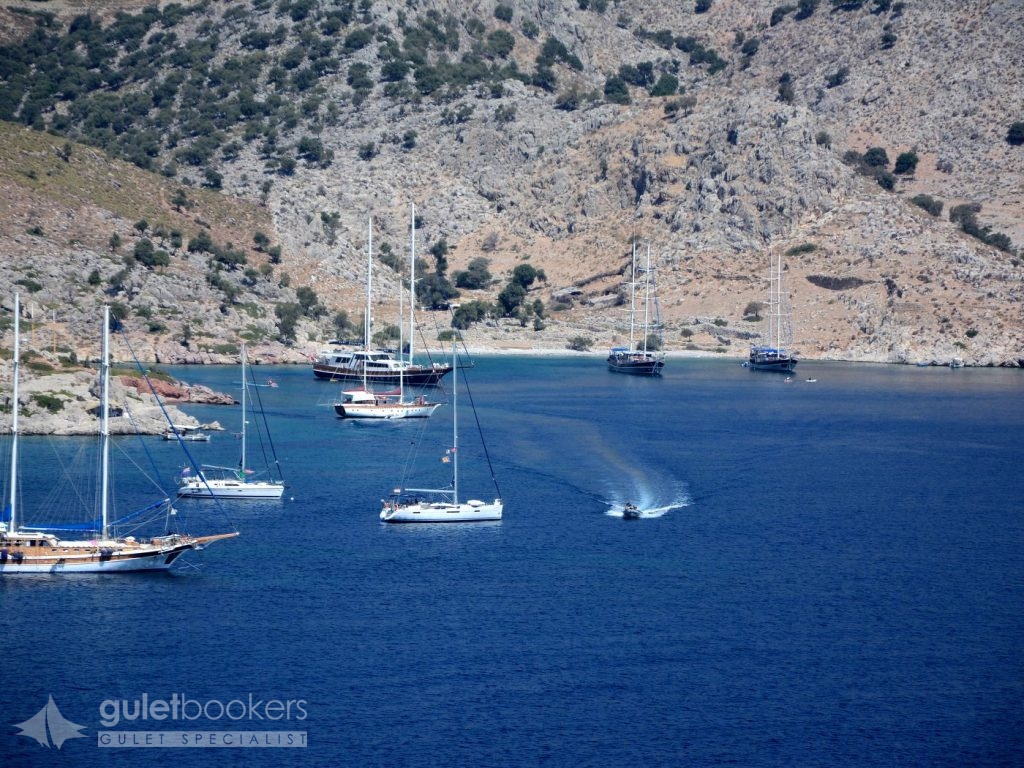
Serce
Along the peninsula, and heading to the south-east, lies the bay of Serce – a large bay hidden behind steep cliffs. It was here that George Bass discovered a shipwreck, and its artifacts are now on display at the Museum of Underwater Archaeology, in Bodrum Castle.
Bozukkale (Loryma)
Bozukkale or the ruins of the ancient city of Loryma, which are among the poplar stopping points for the boats/yachts/gulets running from Marmaris to Gulf of Hisaronu. The gulf of Bozukkale, which is sheltered against the wind, is one of the most important spot of the Blue Cruises. The gulf, due to its sheltered natre, was of strategic importance throughout history. In 1412 BC, the Athenian fleet anchored here and in 395 BC the navy was based in here before the Knidos war. The ruins of the ancient Loryma are at the entrance of the cove on the hill that overlooks the gulf. The most important remains from that time is the castle, which is 120 metres long and ten metres wide and is in a fairly good condition. The castle was built in order to protect the entrance to gulf and in time was fortified.
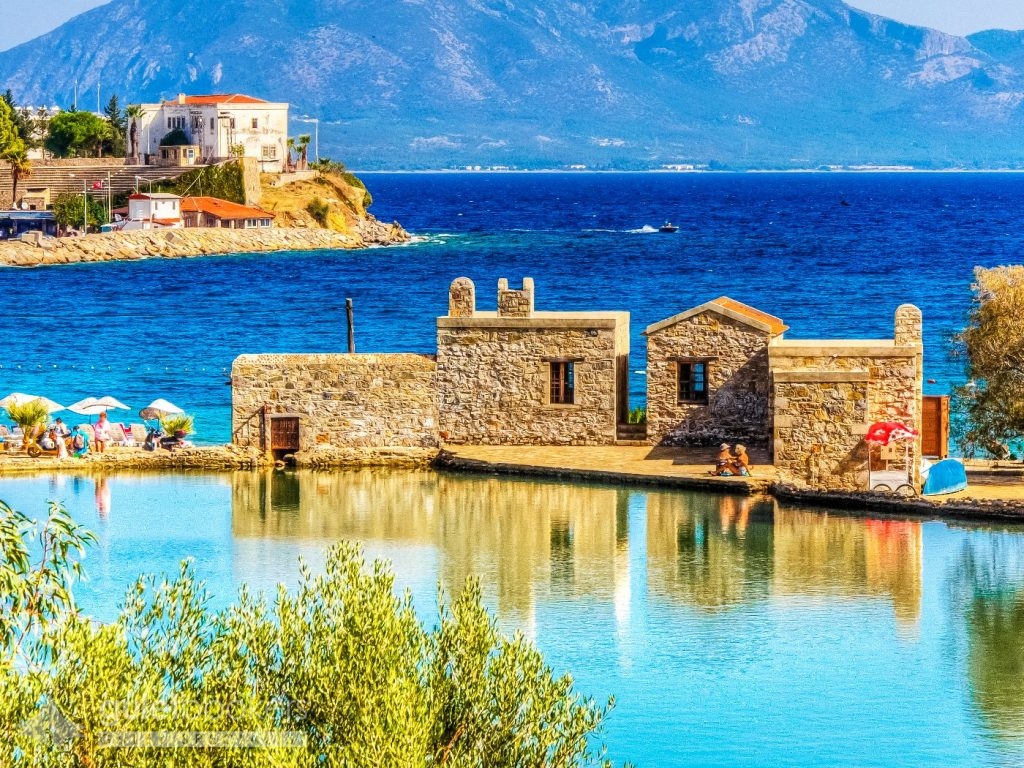
Datca is where the Aegean Sea meets the Mediterranean. One side of the 70 kilometre long Datca Peninsula, which stretches to the west from Marmaris, is lapped by the waters of the Aegean and on the other by those of the Mediterranean. Around the peninsula you will find as many as 52 bays, some of which for one full day will be yours alone. You will not be able to forget the beautiful sea with the stillness of an aquarium in Datca’s coves and beaches. The best and most delicious almonds in Turkey are grown in Datca. Fresh almonds (cagla) are picked in February but there is also a chance to taste them in April.
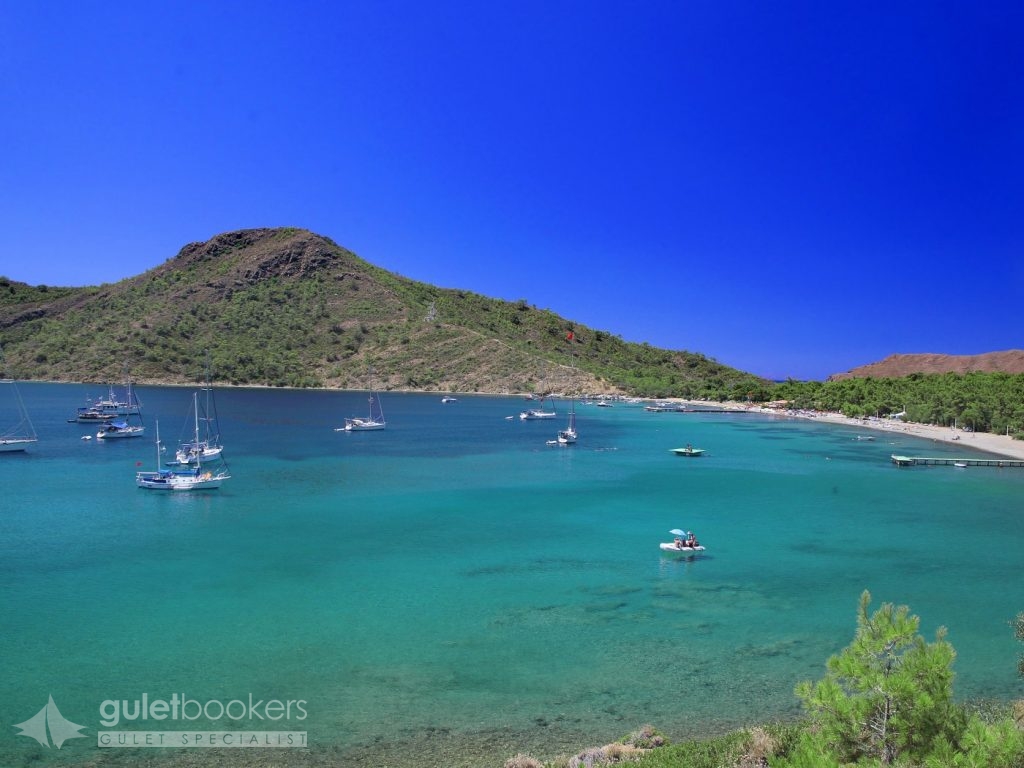
Bencik is a location much loved by the Blue Cruise gulets, with its small coves that maket hem feel very special. There has been no construction allowed to disturb you. In the entrance of the port of Bencik there is Dislice (Teeth) Island, so named because it is covered with rocks that stick out like teeth. It is great to wander through the rocks shaped by the sea, playing hide and seek in the caves or diving to see underwater beauties!
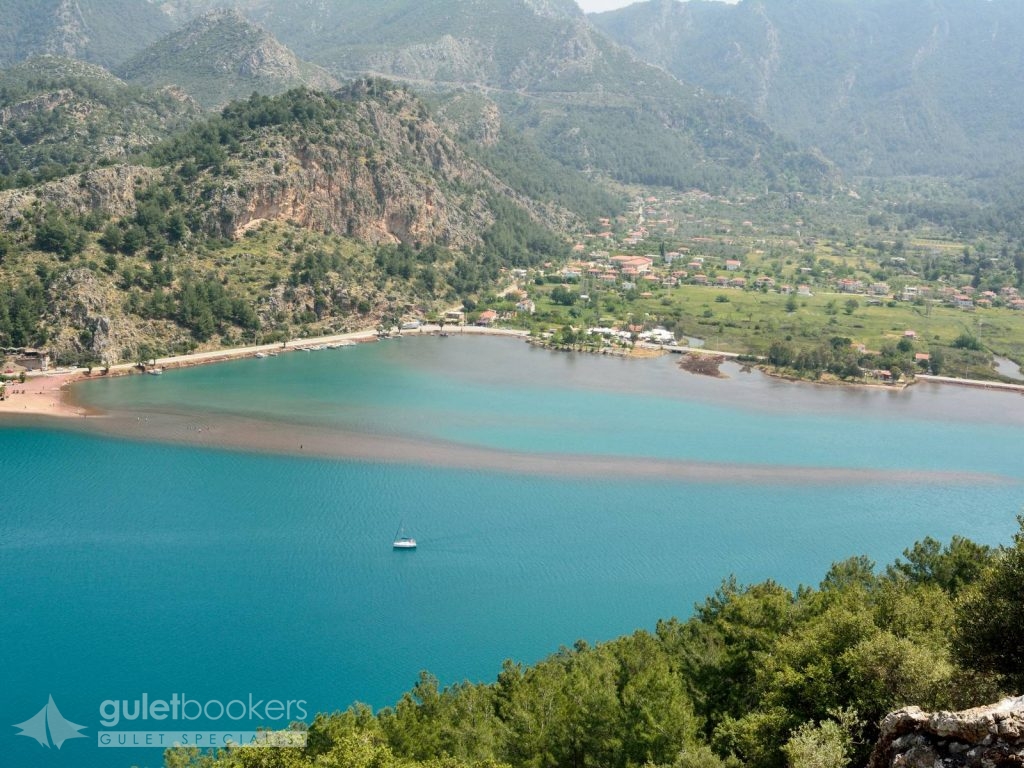
One of the most important tourism centres on the Gulf of Hisaronu, Orhaniye sees the gulets that come to Hisaronu pass through. The sea of Orhaniye is always as flat as a sheet. The coulour of the pine trees that surround the area are reflected on the sea, giving it a shade peculiar to this region. The area is so quiet that when you swim you can only hear the sound you create in the water. You will be puzzled by the sight of people apparently walking on the sea. Thanks to the movement of the sand there is a shallow bar in the middle of the cove that divides it in two. This ribbon, of approximately 600 metres, is called K?zkumu.
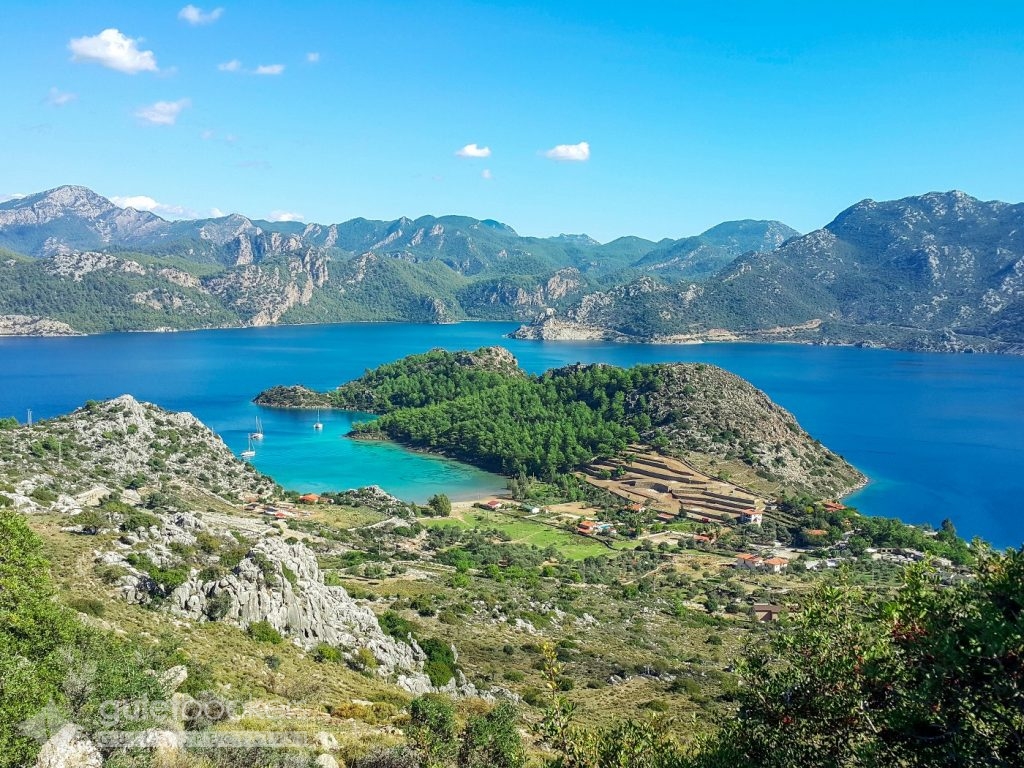
After Orhaniye, you travel another popular stops for gulets on the Blue Cruise between Bodrum and Marmaris. The bay is green, the sea is clean and generally calm but there is not much in the way of sand beaches. There are small restaurants around the quay area. There is an eternal quietness that rules the area, perfect for those that want to have a holiday away from the crowd. There are also historical remains around the Selimiye region. There are ruins of three castles of the ancient city of Hydas in the area. One of them is on the highest hill of Selimiye, one other on Sarikaya Hill and the last in Asarkale in the Kizilkoy district. To the South east of the bay yo ucan visit Hellenistic era city walls.
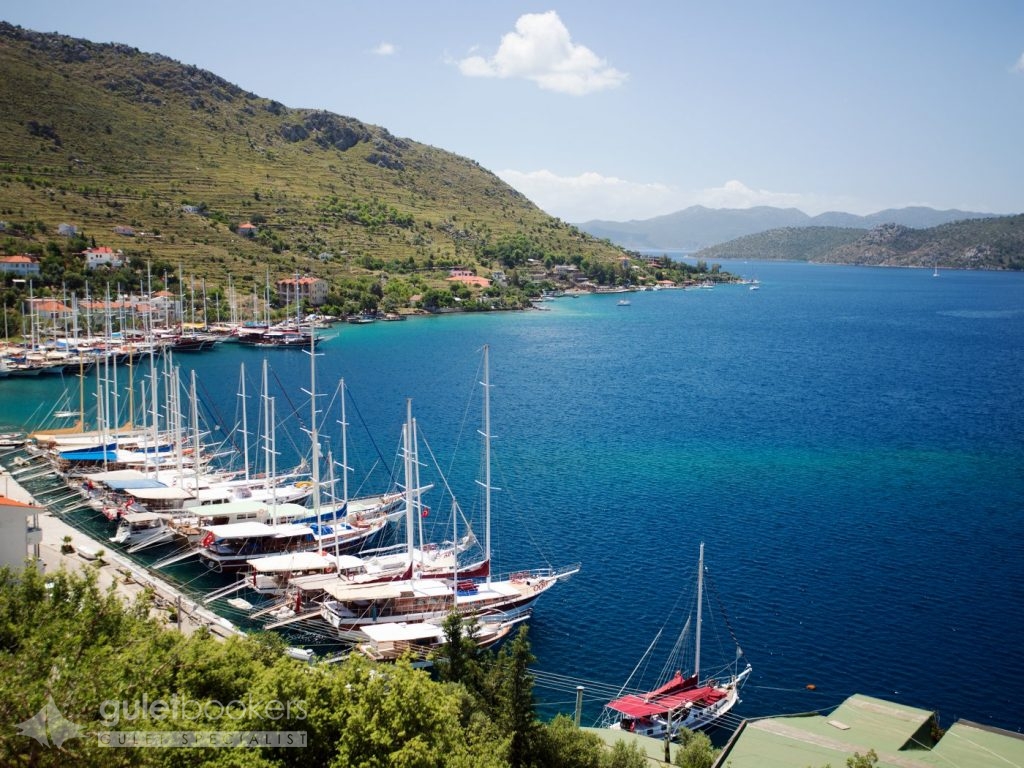
An other place in Hisaronu, named Bozburun is well known to Captains. In respect to tourism it is one of the most virgin parts of the region. Just like the coral waters of the tropical seas, the waters here turn into turquoise fromdark blue. It is highly recommended for those who want a quite and calm holiday. Nearby to Bozburun on Asar Hill are the remains of the ancient city of Larymna. It takes 45 minutes to get to the top of the hill. There are fragments of the city walls, pieces and ruins of tombs scattered around. Bozburun looks beautiful from this hilltop. Another port when you travel towards Bozburun is Sogut Port.
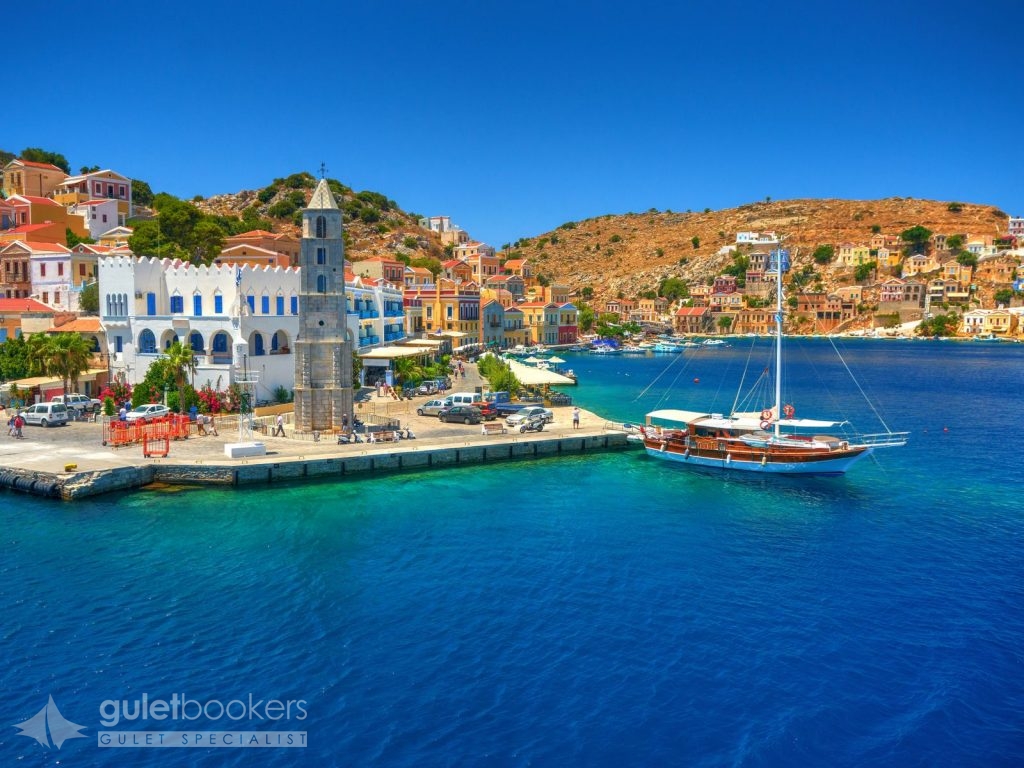
Symi is a cosmopolitan island that has one of the biggest and most beautiful neoclassical towns in the whole country. It boasts a rich tradition in myths as it was first inhabited in the prehistoric times. King Nireas became a legend as he participated in the Trojan War. The locals became engaged in sea sponge harvesting and shipbilding and that is why during the Turkish Occupation (since 1522) the islanders secured firmans of preferential treatment from the Sultan. This is when the School of Agia Marina and Aigli Reading Room were founded. The 19th century is the period of great prosperity for the island when its population had reached 25,000. In 1945, the treaty for the Dodecanese surrender to the Allied Forces was signed on the island. Symi was integrated in Greece in 1948.
The capital town is divided into two large districts. Gialos is the port of the island that never fails to impress visitors with its magnificent neoclassical multi-coloured buildings next to the sea and on the hills and Chorio, the other district, is the larger of the two. Apart from the approximately 3-kilometre asphalted road that connects Gialos and Chorio there is also Kali Strata: 500 wide stone steps climbing uphill and connecting the two districts. Kali Strata is flanked by the largest mansions in Symi.
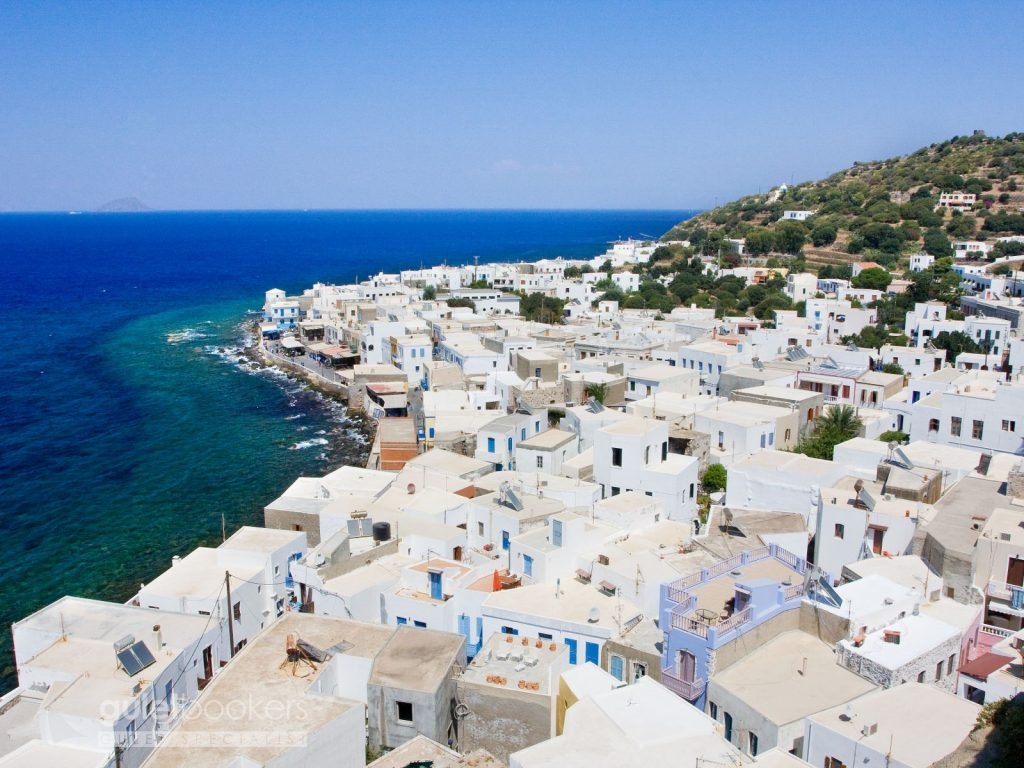
Nisyros is one of the most beautiful Aegean Islands, yet untouched by tourism growth. According to Mythology, the island was created during the Gigantomachy, the battle between the Giants and the Gods. During that battle, Poseidon pursued the Giant Polyvotis to Kos, cut off a piece of the island and hurled it onto the Giant, thus sinking him into the Aegean Sea for eternity. That legendary piece of rock is Nisyros and the eruptions of its volcano are the wrathful breathing of the defeated Giant. Nisyros island was created from these volcanic eruptions making it the “newest” of Greece’s volcanic centres and still an active one – along with the volcanic centres at Milos, Santorini, and Methana. In antiquity, Nisyros had a thriving trade in obsidian which the island’s inhabitants would extract from the nearby island of Gyali.
Beatiful Mandraki is the island’s capital town and port. Its squares feature amazing pebbled paving, and the narrow alleys are flanked by white or coloured two-storey houses with wooden balconies. The houses have been built using volcanic rock and have been insulated with pumice. The volcano is remarkable to see when you arrive to the island. You can walk in the caldera and watch the bubbling steam vents. At the caldera’s bottom there are ten craters in very good condition, each with its own name. The largest and most impressive one is called “Stefanos”. It has an elliptic shape; its longest axis reaches 330 m and the shortest one is 260 m long, while its depth goes down to 27 m. The volcano forms a valley (caldera) that is 2,400 metres long and 950 metres wide.
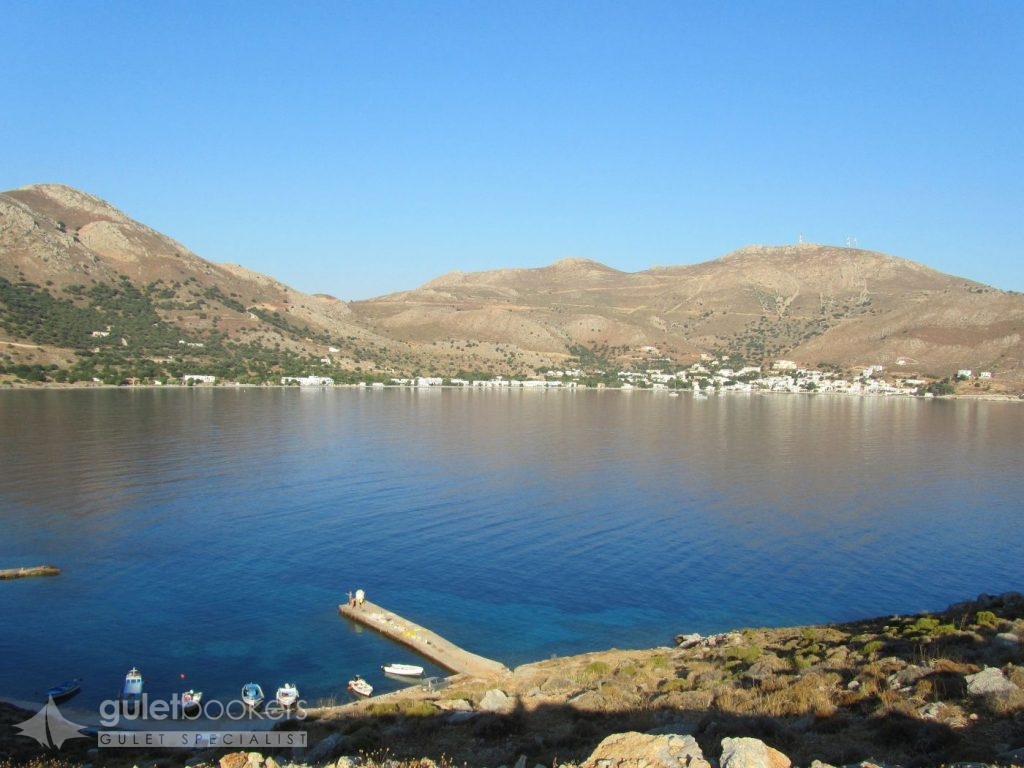
The ragged, mountainous terrain of Tilos; its densely forested ranges; its hilly vistas; and its verdant valleys, are home to four hundred species of flowers and herbs and the habitat of rare species of birds such as Bonelli’s eagles, hawks, nightingales, goldfinches, herons and bee-eaters. You will find picturesque villages and fascinating beaches. The last elephants on Europe lived here. The dwarf elephants made their appearance on the island 45,000 years ago and became extinct approximately 4,000 ago. The entire island is a huge ecological park and is protected by the relevant international treaties. In antiquity, Tilos was renowned for its herbs. It rose to prominence during the ancient classical times, the period when Irinna, a famous ancient poetess, lived on the island. Megalo Chorio is the island’s capital, 7 km NW of the harbour. Stone houses built according to the island’s unaffected traditional architecture make this small town stand out. Strolls along the narrow alleys are a pleasant pastime. The medieval castle has been built on the location of ancient Tilos town at the top of the hill.
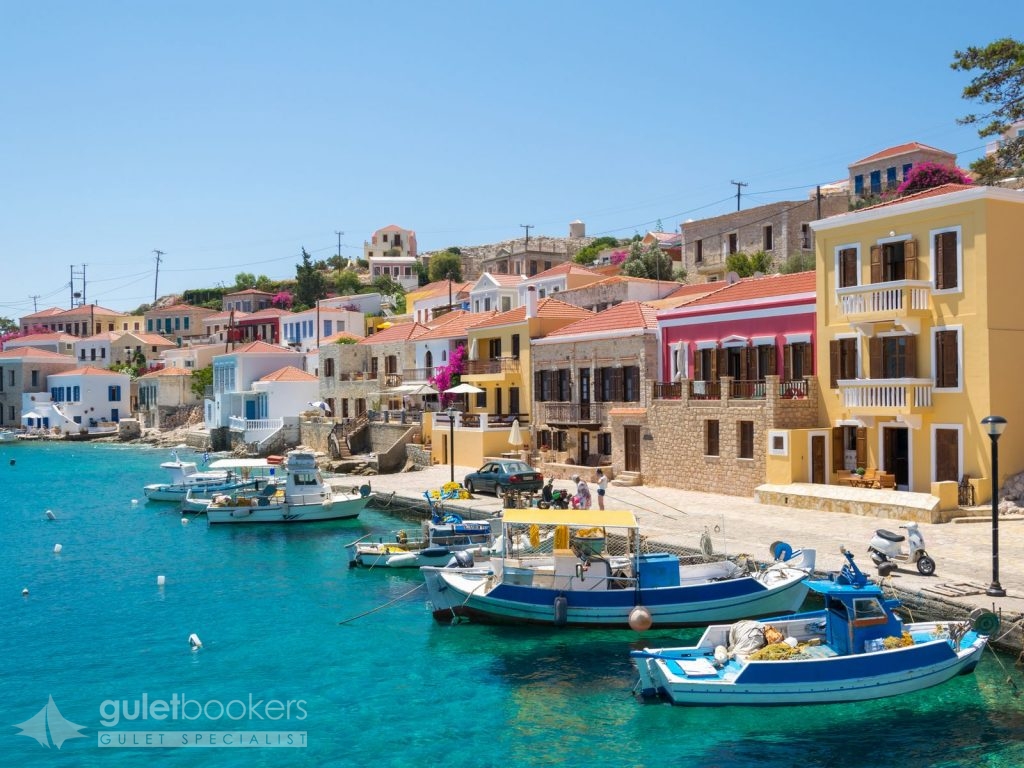
Chalki has been named after the copper (chalkos) mines that used to exist on the island. As of 1983 it has been known worldwide as the “Island of Peace and Friendship” for the young; it offers an enjoyable stay in an enviable serene setting. Chalki prospered in the late 19th century when the islanders became engaged in shipping and the sea sponge trade. Chalki shared the historical path of Rhodes and the island was integrated in the Greek state in 1948. Nimporio is the island’s capital town and has been built in an amphitheatre-like manner, overlooking the crystal-clear blue sea. It keeps a stately beauty, evident in the picturesque alleys and the singular architectural features that adorn the houses; it is one of the most beautiful neoclassical towns in Greece! Chorio used to be the island’s old capital and it was built next to the mighty castle of the Knights Hospitaller of the Order of St John for protection against the pirates. Once the pirate threat had been removed, the locals founded Chalki town or Nimporio (1850-1870) and built magnificent mansions; the latter manifest today the island’s past prosperity times. Chalki has been listed as a heritage town.
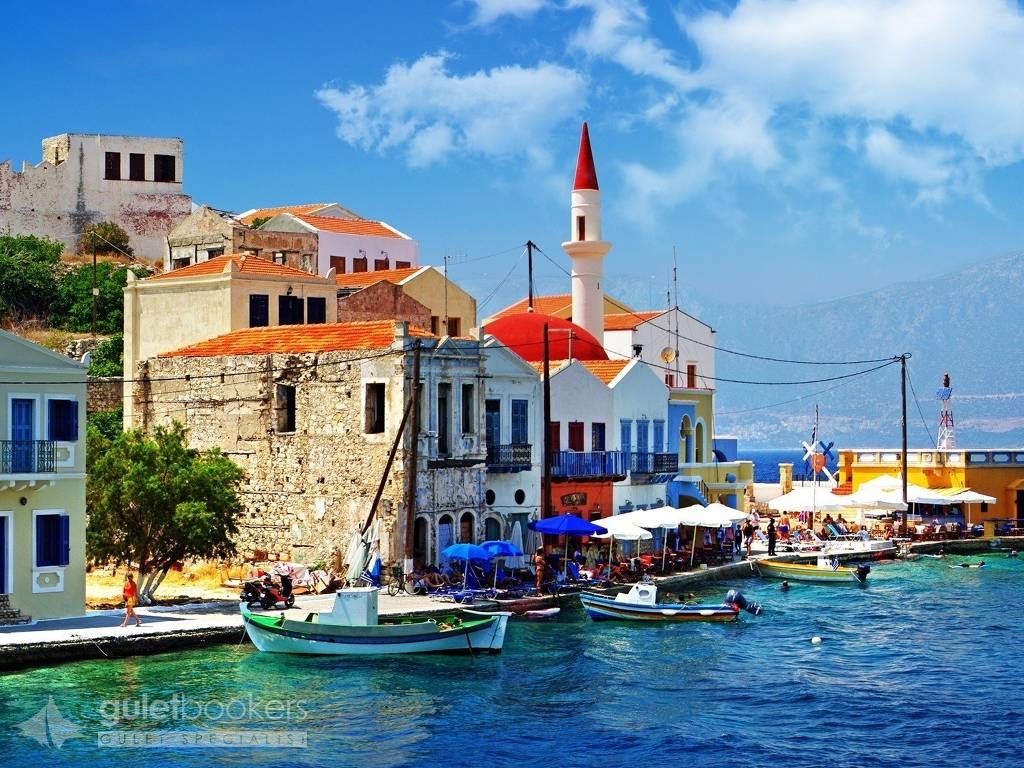
Rhodes is the fourth largest island in Greece, after Crete, Evoia and Lesvos. Endless stretches of coastline and pine forests on mountains dotted with villages, archeological sites, and a medieval city of exceptional beauty attract over a million tourists every year. Rhodes is the largest of the Dodecanese Group with an area of 1,398 sq. km, a coastline that reaches 220 km. It has been populated since prehistoric times and flourished during the Mycenaean period. It enjoyed great prosperity in the 4th c. BC when the Colossus of Rhodes was erected, a work of art by Chares from Lindos, Rhodes, a disciple of the sculptor Lysippos. After the destructive earthquake in 155 AD, Rhodes knew many conquerors (Persians, Arabs, Saracens and Selzuk Turks). In 1309, the Knights Hospitaller [Order of the Knights of Rhodes] acquired the island and restored the castle adding fortifications that were unmatched in Europe at the time. This castle remained the seat of the Knights until 1522 when the Turks conquered it after tough fights. In 1912, Rhodes became occupied by the Italians until 1948, when Dodecanese became integrated in the Greek state.
The capital of the island is considered to be one of the most beautiful cities worldwide. It was founded in 408 BC. Its medieval architectural features blend with the modern style in buildings. The city comprises the old, fortified medieval town and the modern one, with its old, neoclassical buildings and other recent structures. The medieval town is a UNESCO World Heritage Monument and has been built in a semi-circular fashion around the central harbour.
Send Enquiry Pearls of Aegean Cruise : Turquoise & Greek Islands
This itinerary is only bookable for private charters. If you are interested in a cabin charter, please contact us for more information.
Guletbookers is the independent gulet charter company located in Bodrum - Turkey and dedicated to giving you
the best gulet charter possible from the widest choice of gulets possible.
Get in touch via WhatsApp for Seamless Communication.
Talk to our experts and browse through more yachts.







